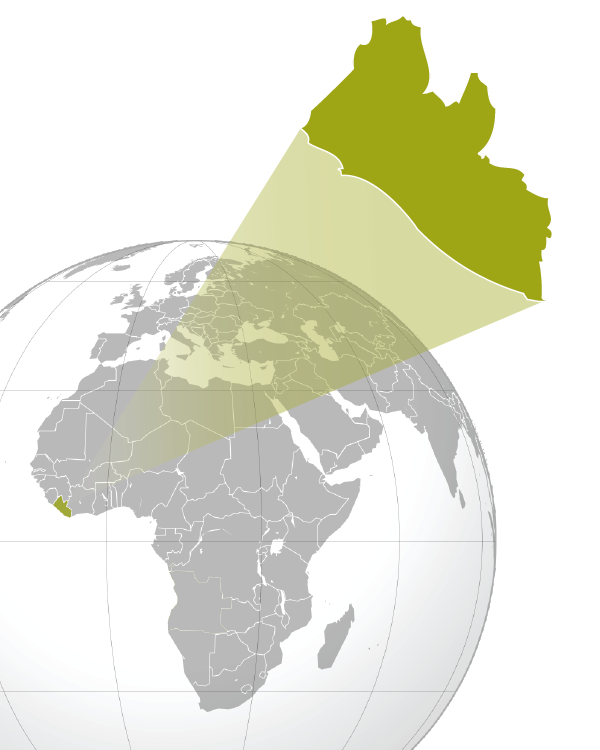Project Dates: 2011 – 2012
 Background
Background
Liberia continues to recover from more than a decade of civil war, and has made significant progress in improving delivery of basic health services. The 2007 Demographic and Health Survey[1] (covering 2002–2006) reported appalling statistics: Maternal mortality was at 994/100,000, child mortality was extremely high at 110/1,000 live births, and infant mortality ranging from 69/1,000 live births in Monrovia to 142/1,000 live births in some rural areas. Malaria was the leading cause of death. The prevalence of malaria parasitemia in children under five was 66%[2] with ownership of nets (treated or untreated) ranging from only 9% in the northwest to 39% in the southeast. HIV prevalence was 1.8% and 1.2%, respectively, among women and men aged 15–49. In 2011, the US Agency for International Development (USAID), under PMI, funded the SIAPS Program to take over support to the National Malaria Control Program, building on the solid foundation established by SPS. The main goal of SIAPS in Liberia was to improve the supply, quality, and use of malaria commodities, services, and other key pharmaceuticals in the counties of Bong, Nimba, and Lofa.
Project Highlights
- Launched, disseminated, and provided orientation on important pharmaceutical documents: The revised National Therapeutic Guidelines for Liberia, Essential Medicines List, and Malaria Treatment Guidelines were rolled out to all health facilities and pharmacies in Nimba, Lofa, and Bong Counties. The roll-out of these tools in Montserrado County was done in coordination with the Supply Chain Management Unit and the Pharmacy Division of MOHSW. SIAPS also supported the Liberia Medicines and Health Products Regulatory Authority in the development of their National Strategic Plan 2010–2015.
- Built staff capacity: SIAPS built the capacity of health and pharmacy professionals (officers in charge, pharmacists, and medicine store dispensers) in pharmaceutical management.
- Developed a pharmaceutical management training manual: In-depth five-day trainings were provided to officers in charge and dispensers; 141 staff in Bong, 141 in Lofa, and 103 in Nimba Counties were trained on store management, inventory management, LMIS, rational use of medicines, and monitoring and evaluation. SIAPS, in coordination with the NMCP and the county health teams, conducted three supportive supervision visits to the counties.
- Established the private sector Artemisinin-Based Combination Therapy Technical Working Group: Also provided regular support to NMCP to host the meetings.
- Supported quarterly end use verification (EUV) surveys
- Supported renovation of Nimba County Depot on the basis of EUV report findings: Observations of the poor state of storage of essential medicines in Nimba were made during supportive supervision visits.
- Supported to expanding access to ACTs in the private sector: SIAPS worked through the issues surrounding a consignment of PMI-procured generic artesunate/amodiaquine. They also established a private sector distribution system. To strengthen the capacity of the private sector dispensers in Paynesville and St. Paul River districts of Montserrado County, SIAPS trained 120 medicine store and pharmacy dispensers in malaria case management, with a focus on ACTs and mRDTs.
Results
- SIAPS supported the Nimba County health team in renovating the medicines depot with interior and exterior painting, renovation of the reception area (tile work) and new desks, chairs, and shelving.
- In coordination with the NMCP and the Pharmacy Board of Liberia, memoranda of understanding were developed and signed with the NDS Pharmacy 1 outlet and private sector outlets for the roll-out of ACTs and RDTs.
- SIAPS provided safety-disposal boxes and gloves to each private sector medicine store and pharmacy where trainings had taken place.
References
- Feasibility of Introducing ACTs and RDTs in Private Sector Pharmacies and Medicine Shops in Montserrado County, Liberia: A Qualitative Study
- President’s Malaria Initiative: Private Sector Distribution of Artemisinin-Based Combination Therapies in Liberia

